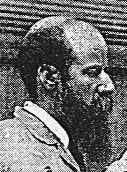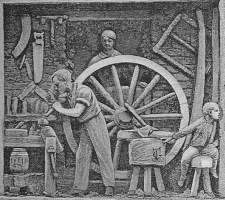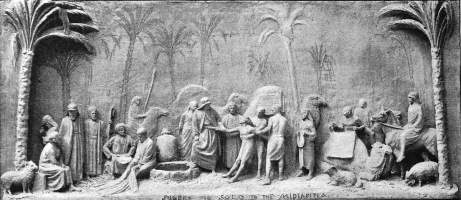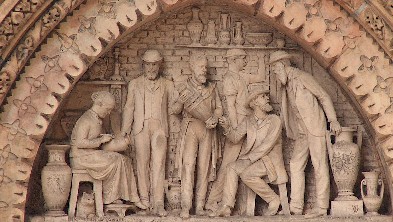George Tinworth (1843-1913)
George Tinworth was a prolific and important terra cotta sculptor of the later 19th and earlier 20th Centuries. His moulded panels, in naive but well composed fashion, became very popular.
George Tinworth at work.
'Mr George Tinworth, though in his practice not a sculptor properly so called, can hardly be omitted some sort of companionship in view of the peculiar position he has taken in the estimation, not to say the affections, of a section of the public. Yet he had a sculptor's training...' Spielman, 1897.
Panel by Tinworth showing a Wheelwright's shop.
The sculptor in terra cotta, George Tinworth, was born into a poor wheelwright's family in Walworth (see the perhaps slightly autobiographical panel above). Despite having no friends or relatives with artistic inclinations, Tinworth wished to be a sculptor from boyhood, and would, encouraged by his mother, surreptitiously produce carvings when his father could not observe him. From 1861 he was able to undergo a proper sculptor's training, first taking evening classes at the Lambeth School of Art, a pupil of Sparkes. Then in 1864 he was able to enter the Royal Academy Schools, where he obtained various medals, and exhibited his first RA work in 1866 - a group of children fighting called Peace and Wrath in Low Life.
When his father died in 1867, Tinworth had to support his mother and himself with wheelwrighting, until his old teacher, Sparkes, introduced him to Doulton, whose firm employed him for the rest of his life. Among early sculptural works for Doulton's, Tinworth produced some oversized copies of antique Greek and Italian coins, which came to the notice of John Ruskin, who was a strong supporter thereafter. Spielman, the critic, referred to the popularity of Tinworth's work as being
'...out of all proportion to their sculptural merits; yet it cannot be denied that in the spirit that inspires them, and in the deep religious sentiment with which they overflow, there is ample justification for the public favour. Not for their art's sake, but for the vivid drama and intense passion with which the subjects are presented, they go straight to the heart of the devout or the unsophisticated spectator.'
Typical Tinworth panel - Joseph sold to the Midianites.
Others were less favourable:
...Tinworth... merely attempts, by the aid of his own uneducated observation of human nature,... to interpret the teaching of the New Testament. With a certain rough vigour and unpleasant puritanical humour... the figures are modelled with a rude energy and untutored strength which are undeniable... the composition is too pictorial for sculpture, and the modelling has neither subtlety nor distinction of character. If the humour were removed from Mr Tinworth's work there would be nothing left, and after all humour is not art...
'We confess to having no sympathy whatever with this kind of work. The presence of an uncouth Puritanical humour does not atone for the absence of every shred of artistic quality.'
Tympanum at the former Doulton Works.
The bulk of Tinworth's work consists of hundreds of terra cotta panels, wholly or partially in relief, showing biblical scenes. The religious work included many for various churches in England and abroad, and two big commissions from the Gothic architect G. E. Street - a reredos for York Minster (1876-9, still extant, though moved elsewhere in the Minster), and 28 semicircular panels for the Military Chapel in Wellington Barracks (mostly bombed). Secular work includes the Amazon Vase, which went to Fairmont Park, Philadelphia, and a fountain for Kennington Park in South London, destroyed except for a single extant pillar. A panel above the entrance to the former Doulton Works in Lambeth happily does survive (see this page and below), and religious panels may be seen in the Museum of Garden History nearby.
Tinworth's panel work tends to be crowded, with extra figures and generally busy compositions with actions going on at the sides, which, as for other aspect of his work, attracted a degree of criticism from contemporary critics. Another way to look at his rather literal sculptural interpretation of scriptural scenes is simply as illustrations, comparable to the more or less contemporary printed illustrations of religious works favoured by the Religious Tract Society.
Tinworth also had a few full-sized statues to his name. A memorial to Fawcett in Vauxhall Park does not survive - the picture of Tinworth at the top of this page shows him working on a small version of this. His Christ Blessing the Little Children in Whitworth Park, Manchester, was removed after damage in WW2 and is lost. One statue which does survive is that of Charles Bradlaugh in Northampton. Made of terra cotta, but oddly painted in white, it is a straightforward portrait statue of no great pretension or ambition, but on the other hand, like others of his works, difficult to square with the severe criticisms of his work as noted above.
Charles Bradlaugh statue, before it was painted.




